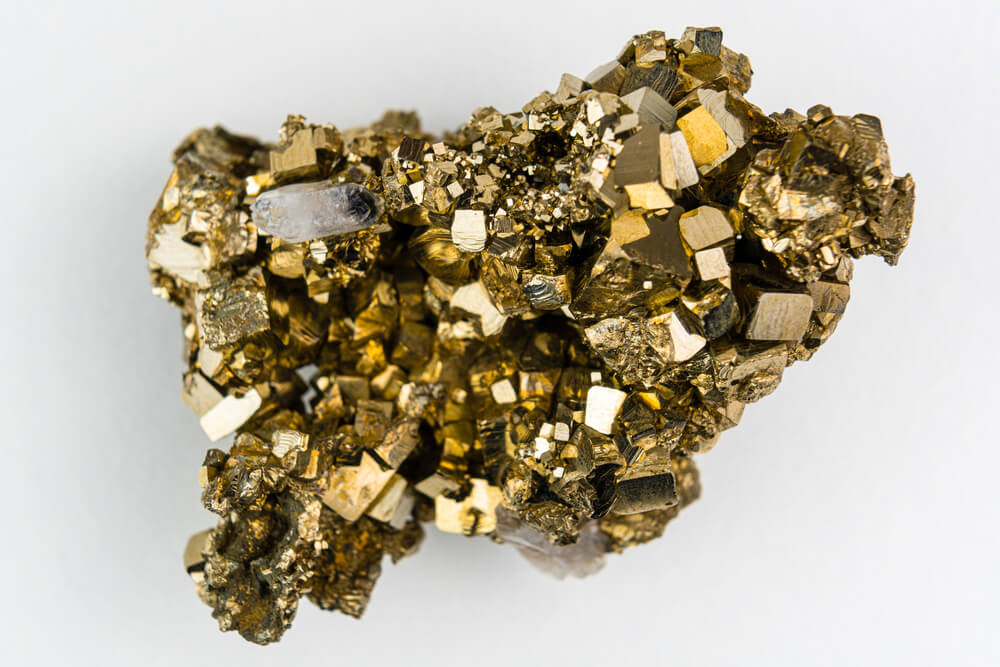
Gold Alloys: A Comprehensive Look
Pure gold, no doubt, has its place. But the solid-state gold is extremely soft and impractical to make jewelry, bullion goods, etc. A gold alloy alleviates that shortcoming. Gold alloys are not fake or imitation gold. They possess unique traits that boost the alloyed metal’s durability, functionality, and aesthetic appeal.

Gold alloys are a big sub-segment of the gold industry. From jewelry to tools, alloyed gold is used in different ways and purposes. Gold is non-corrosive and, therefore, used in electronic components. Gold alloys are also used instead of pure gold, depending on how much gold and other base metals they comprise and the non-corrosive nature of the added metals.
Table of Contents
To broaden your understanding of gold alloys, this article shall throw massive light on the following:
- The concept of gold alloys
- Types of gold alloys
- Manufacturing and processing gold alloys
- Various applications of gold alloys, etc.
Read more: Real vs. Fake Gold
To broaden your understanding of gold alloys, this article shall throw massive light on the following:
- The concept of gold alloys
- Types of gold alloys
- Manufacturing and processing gold alloys
- Various applications of gold alloys, etc.
What is a Gold Alloy?

A gold alloy is fine gold mixed with other metals in variable proportions. The secondary metal(s) is usually a noble metal, like gold, resistant to oxidation and corrosion, making the alloyed metals unreactive and highly stable under normal conditions. If a non-noble metal is used, it’s usually in minimal quantities. For example, zinc, not necessarily a noble metal, is used minimally in gold alloys. Alloying gold with other noble metals helps retain the yellow metal’s noble characteristics.
Gold alloys can have gold content as high as 91.6 percent and as low as 33.3 percent. The range is quite broad, with several other alloy mixes in between. The alloying metal can alter the hardness, color, workability, and durability, broadening the alloy’s uses or applications. Gold alloys facilitate complex metalwork and intricate jewelry designs.
A gold alloy’s makeup is usually expressed in “karats,” which denotes the percentage of gold in alloyed gold. Pure gold is 24 karats. Karat figures range from 24 to 1. Twenty-three karats represent the most gold in an alloy. The 22k (91.7 percent gold) to 10k (41.7 percent) range is the most common. The lower karat gold alloys render the piece more robust or resistant to denting and scratching. It also makes gold jewelry more accessible to the masses.
Types of Gold Alloys
Mixing gold with other metals started to offset the high malleability of gold and make it more versatile and suited for a wide range of applications. Gold changing colors when mixed with other metals was one of the outcomes. The following are the types of gold alloys based on their color or physical properties.
Yellow Gold Alloy
A yellow-gold alloy is an alloyed gold that retains gold’s original color. It’s meant for those who don’t want the addition of other metals changing the classic look of gold. Yellow gold alloys are ideal for vintage-inspired, traditional, and elaborate jewelry designs. They are commonly used for wedding bands, engagement rings, bracelets, necklaces, and earrings. The golden hue’s warmth and radiance also complement various gemstones (such as diamonds), pearls, and colored gemstones. The gold alloy is also used to make luxury accessories, dental applications, etc.
Yellow gold alloys usually comprise silver and copper, besides, of course, gold. An 18k yellow gold alloy, for instance, has pure gold (75.5 percent), silver (15 percent), and copper (9.50 percent). The elemental or chemical compositions can vary based on the karat numbers and the shade of yellow being sought. For example, if the 18k piece is the “rich yellow” kind, it may also have less silver, more copper, and some zinc. Pure gold is usually orangey yellow, whereas yellow gold alloys are bright yellow.
Look at the table below to learn how different karats mean a diverse mix of metals and compositions:
| Karats | Gold | Silver | Copper | Zinc |
| 10k | 41.7% | 7% | 44% | 7.3% |
| 14k | 58.5% | 5% | 31.25% | 5.25% |
| 18k (classic yellow) | 75.5% | 15% | 9.5% | - |
| 18k (rich yellow) | 75.5% | 12% | 11.25% | 1.25% |
| 20k | 83.5% | 10.25% | 6.25% | - |
| 22k | 91.75% | 5.25% | 3% | - |
Source: Carrera Casting
When karat numbers go down, the copper content increases to balance the plummeting gold presence, preventing the alloy from losing its yellow color. Silver contributes to the alloy’s brighter mien overall.
White Gold Alloy
White gold alloys blend fine gold with palladium, zinc, nickel, and other white metals. White gold has a silvery-white look, similar to platinum. It is usually viewed as an inexpensive alternative to platinum. White gold is more pliable than platinum. Rhodium plating is typically added to white gold to make it look the part. White gold is primarily used in the fine jewelry realm. Its neutral hue makes it ideal for pairing with gemstones of varied shapes and colors.
Unlike yellow gold, white gold is more discreet, which millennials prefer. Young professionals prefer their gold rings in white if a platinum ring is out of bounds. White gold is also increasingly preferred over traditional yellow gold in the luxury goods space, mainly watches. Typical white gold compositions are 18K and 14K since the proportions are well-suited to achieve the white hue organically.
White Gold Allergy
Gold alloy jewelry can cause an allergic reaction. It’s primarily due to nickel, commonly used in white gold. If you’re allergic to the metal, you can opt for hypoallergenic white gold or white gold covered with a relatively thick rhodium layer. Jewelers make white gold hypoallergenic by decreasing or substituting nickel in the composition. Palladium gold, for example, is hypoallergenic white gold. Palladium alloys and also platinum gold alloys have hypoallergenic attributes. Palladium gold is gold, palladium, and other metals, such as copper or silver.
Hypoallergenic doesn’t necessarily mean allergy-free, and individuals with severe metal sensitivities or allergies could still react to hypoallergenic white gold. Also, the plating can wear off and must be reapplied to prevent nickel contact with the skin. If you’re sensitive to nickel, buy white gold from a jeweler who sells hypoallergenic gold alloys.
Rose Gold Alloy
Also called red gold or pink gold, rose gold alloys contain more copper than the above two gold alloys, providing a distinctly rosy hue and sufficient durability. Rose gold has existed since the early 19th century but has only recently gained widespread popularity. Rose gold could assume a reddish or pinkish hue based on the exact composition.
Rose gold appeals more to female buyers and strikes a solid balance between contemporary fashion and classical elegance. Rose gold’s warn undertones complement different skin tones, making it a flattering and versatile gold alloy. Rose gold alloys suit varied jewelry designs, from Bohemian and vintage-inspired to minimalist and modern.
Other Gold Alloy Colors
Yellow, rose, and white are three common gold alloys. But they aren’t the only hues a gold alloy can assume. Gold alloys can take up quite a range of colors and shades based on the different metals added, their compositions, and their proportions. The following are some of them:
- Green: Green gold alloy, also called greenish-yellow gold, has a mild greenish hue. A mix of silver, copper, zinc, cadmium, and other metals forms green gold. The green is usually very mild and can look yellowish from certain angles based on the light hitting it.
- Blue: Blue gold forms when pure gold and indium or gallium blend. Based on the proportions and composition, the blue color achieved could be a mild blue to a more intense indigo.
- Purple: Also called amethyst gold or violet gold, purple gold is fine gold alloyed with aluminum. Purple gold is rare and primarily used in experimental and artistic jewelry creations like the colored golds mentioned above.
- Black: Black gold is usually a combination of fine gold and cobalt. The two are not melded. Instead, fine gold or alloy gold surface is treated with cobalt oxide, darkening out the pure metal. Jewelers could also employ laser treatments, enameling, black rhodium gilding, or electroplating to blacken the gold. There’s no single method or technique to make black gold alloys.
Mixing gold with other metals is usually insufficient to make the gold alloy assume more radical hues. To achieve deeper colors like brown and black, methods like creating patinas or oxides on their surfaces through chemical or thermal processes or adding a layer of different metals are common.
What Do the Different Alloying Metals Bring to the Table
When other precious metals, such as silver and copper, are added to gold, they change the alloy metal’s attributes and appearance. The choice and quantity of the alloying elements added to gold influence the characteristics of the alloying gold significantly. Here is a brief look at what the different gold alloy metals bring.
Silver
Silver is commonly used to make white gold alloys. The resulting alloy achieves a white or greyish hue based on the amount of or the various proportions in which silver is added to the gold and the other metals used in small quantities. Silver is a harder, more malleable, and more ductile metal than gold. Adding silver to gold means enhanced malleability and workability.
Note that the silver used to make a gold-silver alloy is regular silver, not sterling silver. Sterling silver is an alloy comprising pure silver (92.5 percent) and the remaining copper and other metals. It’s alloyed with gold and other metals to make gold vermeil, essentially a sterling silver base plated with gold that’s at least ten karats and measures 2.5 microns thick.
Copper
Copper is usually added to gold to create red gold (rose gold) or yellow gold alloys. It also is known for lending high levels of robustness to the alloy. Adding copper to gold also boosts the resulting alloy’s resistance to wear, rendering copper alloys ideal for purposes where durability is paramount, such as everyday jewelry.
The strength and hardness of a copper alloy can be altered by modifying the copper proportion. But, as mentioned earlier, more copper in the pursuit of durability could considerably change the alloy’s color or cause the gold to assume a more reddish tint. Ensure a proper gold-copper balance if you want the gold alloy to continue looking yellow.
Palladium, Zinc, and Nickel
Palladium lends a bright silvery-white hue to gold. It is commonly used in white golds. Nickel is another metal widely used in white gold. But because it may cause allergies in some users, it’s often replaced by platinum and palladium. Palladium and nickel are rarely part of the same alloy of gold. Palladium lends durability and longevity to gold alloys and can withstand routine wear and tear.
Zinc lends strength and rigidity. The metal doesn’t significantly alter the color of gold but may impart a greenish or pale yellow tint to the alloy. Because zinc’s melting point is lower than gold, it helps lower the alloy’s overall melting point, making the gold alloy’s melting and casting process easier and reducing its energy consumption.
Although nickel is commonly used in white gold, its usage has declined over the years, thanks to the potential skin allergy issues it presents. Nickel is a strong metal and offers wear and deformation resistance to a gold alloy. Also, it increases the viscosity of gold alloys, creating detailed features and intricate designs.
Gold Alloy Production and Processing
A gold alloy is made by blending the precious yellow metal with different elements. The various stages of gold alloy production emerged only in the modern era. A couple of centuries ago, there weren’t metallurgical techniques and scientific comprehension to make gold alloys precisely and in the correct proportions. Being able to alloy gold and other metals in controlled environments and using advanced manufacturing and casting methods have only enhanced the versatility and quality of gold alloys.
Although making gold alloys is a complex process, it can be simplified and broadly classified as the following:
Refining the Gold
Refining the gold is the initial step in making gold alloys. The process helps remove impurities from the material to achieve the highest purity level. The refining phase entails melting the gold in a furnace, usually combined with fluxes. Flux mixes different reagent chemicals like silica, borax, sodium carbonate, nitrate, and fluorspar.
Then various chemical processes like electrolysis or acid leaching are implemented to remove impurities. Then, the solution is sieved to remove leftover impurities, and a chemical reagent is thrown in to make the gold precipitate out. Next is smelting, wherein the precipitated yellow metal is remelted to create solid gold bars.
Manufacturing Gold Alloys
The manufacturing process entails merging refined gold with other metals and making alloys. The refined metal is first weighed. The desired amount of the alloying metal is ascertained depending on the chosen alloy composition. The measured quantities of the alloying metals and refined gold are then mixed and dissolved in a furnace to their melting points and to ensure a homogeneous mix. Next, the molten alloy gets rolled into sheets or poured into molds based on the desired application.
The manufacturing methods used to produce gold alloys could determine the mechanical properties of the alloy of gold. The techniques include rolling, forging, casting, milling, etc., which could impact the alloy’s density, grain structure, and overall quality. Heat treatment, like tempering, annealing, and quenching, could modify a gold alloy’s properties. The processes can alter the alloy’s grain structure, flexibility, and hardness to suit specific applications better. In addition, multiple surface treatments could be done to the gold alloys to boost their look or offer added protection.
Quality Control
Quality control ensures reliability, consistency, and conformance to industry standards. The QC process entails testing and assaying, certification, and documentation. For testing, samples from each gold alloy batch are examined to verify purity and composition. Different analytical methods, such as fire assay and XRF (X-ray fluorescence), could be employed to determine the exact quantity of gold and the various metals in the alloy.
If the alloy meets specific quality standards, reputable regulatory bodies or assay offices could certify the piece. Buyers can rest assured about the quality and authenticity of the alloy with the certification. Each gold alloy batch is documented, or its detailed records are preserved. The papers provided information on the gold alloy’s manufacturing dates, composition, test results, etc., helping with traceability and identifying inconsistencies or issues that may arise later.
Gold Alloy Applications
The gold alloy’s intended use and application can determine the alloy’s composition and properties to a great extent. The following is a broad representation of the sectors gold alloys are used.
Jewelry
Jewelry-destined gold alloys make rings, necklaces and pendants, bangles and bracelets, earrings (hoops, dangle earrings, studs, etc.), watches, pins, brooches, etc. Jewelry alloys need different attributes than gold alloys for the dental industry, electronics, or industrial applications. Specifics such as color, malleability, hardness, etc., would vary. A lustrous look, ductility, and tarnish resistance are properties gold alloys must possess to be highly desirable for jewelry purposes.
Non-Jewelry
Non-jewelry gold alloy applications include electronics, dentistry, coinage, medical equipment, aerospace, artistic items, etc. Gold alloys have excellent conductivity and corrosion resistance, making them suitable for electronic switches, connectors, PCBs (printed circuit boards), etc. Dental gold is used to make crowns, fillings, bridges, and other dental restoration items. Gold alloy’s durability, biocompatibility, etc., make it ideal for dental applications. In the medical realm, gold alloys make pacemakers, implants, sensors, etc.
Gold coins can be either pure gold or a gold alloy. The Canadian Maple Leaf gold coin is pure gold, whereas the American Eagle gold coin is an alloy of gold, copper, and silver. Pure gold coins are usually meant for collection and investment purposes. They never enter public circulation, unlike the South African Krugerrand gold coin. In aviation, gold alloys are employed in engine components, electrical connectors, sensors, etc. Craftsmen and artisans use the alloy in sculptures, fine art, and statues.
Read more: What is the Gold Standard
Conclusion
Gold alloys make gold versatile or expand the precious metal’s range of applications. Melding gold and other metals help create alloys of varied strengths, colors, and durability. If it hadn’t been for the science of alloying pure gold with another metal, the yellow metal might not have achieved the mass status it currently enjoys. It would have been relegated to the vaults of banks and governments and owned by only the wealthy.
In other words, gold alloys deserve much recognition and appreciation for birthing the mass-market jewelry industry and broadening the scope of gold in general. And what better way to do that than learning in detail about them and their various avatars? Hopefully, this article offered all the information you needed to broaden your knowledge about common gold alloys, colored gold alloys, etc., and develop a sense of regard and respect for them.
FAQs
When were gold alloys invented?
Gold alloys have been used right since the ancient civilizations (Egyptian, Greek, Mesopotamian, etc.) and then the middle ages, or basically when the desire or need to enhance gold’s properties was birthed. Although the exact timeframe and origin are tough to ascertain, evidence suggests gold alloys go back hundreds of years.
What is the most common gold alloy?
The most common gold alloy is an 18K piece. It could be any color: yellow, pink, white, etc. An 18K gold alloy is 75 percent gold and the remaining other metals. The 18K gold alloy is particularly popular in jewelry since it balances durability, affordability, and purity. Fourteen-karat is the second most popular gold alloy composition, but some may not prefer it due to its lesser gold content.
Are there naturally occurring gold alloys?
Yes, there are natural gold alloys—electrum, for instance, is a natural alloy comprising gold and silver, with negligible quantities of copper and a few other metals. The exact gold and silver ratio depends on the alloy’s source. The naturally occurring alloy is used to make jewelry and decorative items. Its color could range from a silvery hue to a pale yellow, based on the relative quantities of silver and gold. Besides electrum, natural gold alloys could primarily comprise palladium or copper metals, based on the mineral deposit presence and geological scenarios.
How to check the purity/composition of gold alloys?
Gold alloy jewelry usually bears a sign or mark indicating its karat numbers. The marking is generally found on the insides of rings or the clasps of bracelets and necklaces. You may have to use a magnifying glass to check and read the rating. If bought from a reputed jeweler, take the gold item’s karat rating at face value, as there won’t be any forging, or the numbers will be correct. The karat and millesimal fineness standard uses specific numbers to identify gold purity.
Scratch and nitric acid tests, weight tests, etc., can help determine whether a gold alloy is actual gold. But they won’t reveal if the piece is a 14K, 18K, or 10K alloy. You generally have to take the seller’s word. It’s, therefore, strictly advised not to buy your gold jewels and bullion from a non-reputable source.


